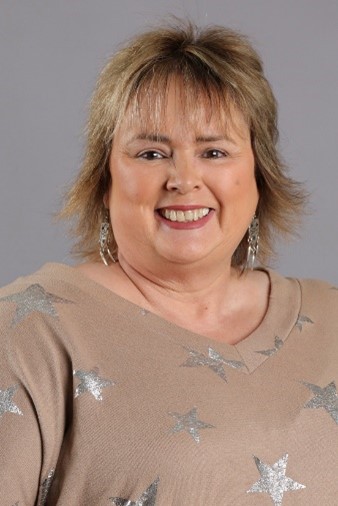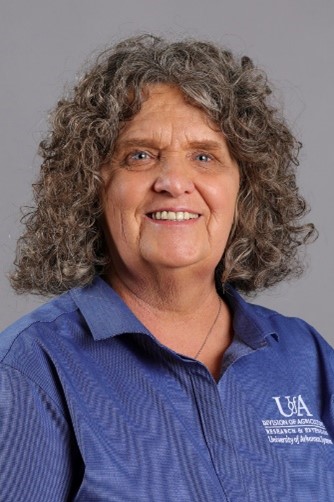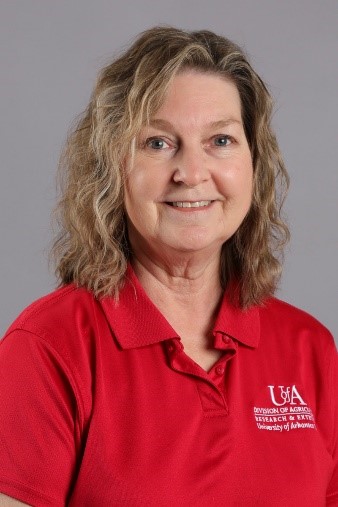Arkansas Nematode Diagnostic Laboratory (ArNDL)
Contact us at nemalab@uada.edu.
Plant-parasitic nematodes are an economically important pest that affect many row crops, horticultural crops, golf courses, and trees and shrubs in Arkansas. Nematodes are host-specific organisms and the strategies for management of the species will vary by crop. Chemical control options for nematodes are limited so often rotation to a non-host crop is the best solution.
The Arkansas Nematode Diagnostic Laboratory offers bioassay and quantification services for the following crops:
- Cotton, Soybean, Corn, and other Row Crops (Root-knot, Soybean cyst, Reniform, Lesion, etc)
- Rice (White tip nematode pest-free certification for export)
- Cedar and Pine (Pinewood nematode pest-free certification for export)
- Turf (Lawns and golf courses)
- Horticultural crops and shrubs (Commercial crops and home garden and landscape, pest-free certification for nursery stock)
- Forage crops
- Custom assays are available (Call for info 870-899-4199)
- Out-of-state samples are accepted per APHIS regulations. Permit must be printed and included with samples. Click here to see our permit.
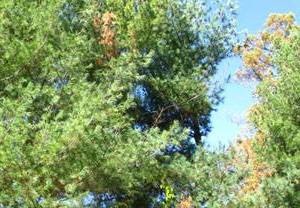
Pine trees near Corning Arkansas with Pinewood nematode (Bursaphelenchus xylophilus)
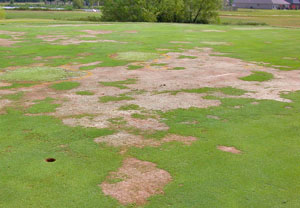
Golf course with nematode damage to putting green
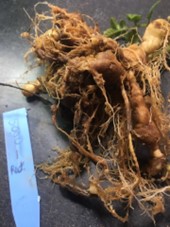
Galling on tomato from infection of Southern root knot nematode (Meloidogyne incognita)
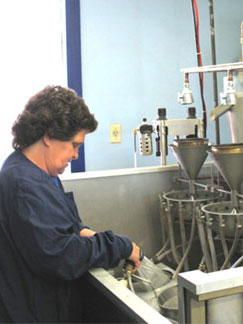
Margie Miller, Agriculture Lab Technician, operates the semi-automatic elutriator for processing nematode samples
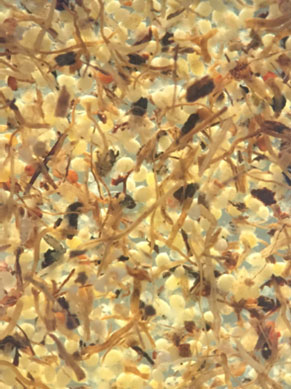
Soybean cysts (female Heterodera glycines) in tray under the stereo microscope
Services and Fees
The following chart details the lab procedures and fee structure. Choose as many methods as applicable for your needs on the submission form.
|
Choose methods as needed |
Examples |
In state |
Out of state |
|---|---|---|---|
|
🔲 Soil |
cotton,soybean,garden |
$15 |
$20 |
|
🔲 Soil + Roots |
turf/lawn,corn,brambles |
$30 |
$40 |
|
🔲 Egg extraction |
soybean cyst |
$15 |
$20 |
|
🔲 Regulatory |
pinewood,nursery,garlic |
$30 |
$40 |
|
🔲 Custom assay |
by request |
call |
call |
A soil assay allows for detection of vermiform nematodes within a row crop, horticultural crop or turfgrass sample. Choosing soil + roots includes an additional process that recovers nematodes that are either unrecoverable or recovered in low numbers in the general soils assay, such as lesion in corn and various the turf genera. For soybean, you will check soil and egg extraction to get both the soil vermiform and soybean cyst egg counts. If egg counts are not needed, choose only the soil method. Race determination of soybean cyst falls under custom and is conducted by request only. This assay can be done IF population exceeds threshold. Allow 50 extra days for testing. If population does not exceed threshold, you will only be charged for your other assay selections.
Custom assays are available by request if the above methods do not meet your needs or if you are working on a specific research project that has other criteria. Regulatory is for testing through government or state agencies to obtain a phytosanitary certificate for export of specific plants.
Sampling Instructions:
Row crops, Annual Ornamentals, Hemp, and Vegetables
Use regular tube-type soil probe, preferred
Insert 6-8" deep in soil near root zone
Collect 10-20 cores in zig zag pattern
Mix and place 1 pint of soil in plastic bag, secure with wire tag, label with pencil. Bags must be clearly marked.
Fruit and Nut Trees, Shrubs, and Trees
Use regular tube-type soil probe, preferred
Collect several cores near root zones of affected plants
If drip lines are present, remove top inch of soil and collect samples that include
feeder roots
One sample should consist of 10 cores 8" deep or 20 cores from multiple plants mixed
together
Place one pint of sampled soil in plastic bag, secure with wire tag, label with pencil. Bags must be clearly marked.
Turf Grass: Golf Courses, Athletic Fields, Lawns, Forages
Use regular tube-type soil probe, preferred
Insert 3-4" in declining (but not completely dead) turf area
Collect 10-20 cores
Mix thoroughly and place 1 pint of soil in plastic bag, secure with wire tag, label with pencil. Bags must be clearly marked.
Regulatory Samples: Nursery, Pinewood, Garlic bloat, White Tip, Etc
These samples may have specific instructions as determined usually by the Arkansas State Plant Board or other regulatory agency. Details will be provided by them on the sampling method and may require direct sampling by the agency’s personnel. Contact them for details. For shipping, must be in a crush proof container and ship early in the week for best results, overnight delivery preferred. Please note: if you choose to ship via the Postal Service, the sample may take much longer to arrive. If timing is important, you may want to ship via UPS or FedEx.
A pinewood nematode assay is required for coniferous products being exported to countries where the nematode is quarantined.
A garlic assay is to detect Ditylenchus sp. in garlic cloves. Submit 4-6 heads of healthy and 4-6 heads of suspect garlic as your sample. Place in crush proof container for shipping (box).
Rice white tip nematode assay is necessary for shipments of rice being exported to countries where this nematode is quarantined, fee $75. (Individuals wanting a rice white tip assay (NON REGULATORY) for non-exported rice may submit the grain samples to the ArNDL for a $30 fee, call the lab before sending)
Submission Instructions:
Traditional Sample Submission Through Your County Extension Agent is Still Preferred
You may still take your samples to your local county agent for shipping and they can provide the forms to be completed for your nematode samples. Your county agent will be able to guide you through the process of submitting nematode samples through your county office or you may contact Cathy Howard at 870-899-4199, nemalab@uada.edu for more information.
NOTE: Requests for nematode analysis are no longer submitted electronically because we have changed software to NClinic.
You will need to fill out a submission form and place a copy of this form in the box with your sample.
We will be entering these in-house. Photos can still be submitted to us via email at nemalab@uada.edu if you want to provide these for additional information. Just be sure to note on your form that these will be arriving so we will look for them. It is very important that the submission form to accompany your samples is filled out completely and accurately.
It is not acceptable to put made-up information in the blanks for filler. It is also not acceptable for the county agent to list their address, phone, or email in the blanks for the client. Your results emails and any other communication will be through the contact information on the submission sheets.
Need assistance?
Please contact Cathy Howard at 870-899-4199.
General Shipping and Sampling Tips
- Place samples in empty ice chest if collecting many and weather is hot
- Do not fill with ice, a cool pack may be added if samples are shipping long distance in summer but do not put in direct contact with sample bags
- Do not leave samples in the sun, even for a short time
- Do not store in hot areas for long periods, air conditioning preferred
- Do not pull samples if muddy
- Place no more than 10 samples per box
- Print and place completed submission forms in box on top of samples, not inside the ziplocs
- Ship to ArNDL early in the week for best results
For more information on how to sample for nematodes, take our online sampling course found here.
Need to consult with a nematology or plant pathology expert?
Contact Cathy Howard, Research Technologist - Plant Pathology at choward@uada.edu
Additional Resources
- MP154 Arkansas Plant Disease Products Guide
The MP154 provides product options for control of plant diseases and nematodes. - MP481 Controlling Nematodes on Golf Courses
- FSA7581 The Guava Root-Knot Nematode (Meloidogyne enterlobii), a Potential Threat to Arkansas Sweet Potatoes and Other Crops
- FSA6141 Controlling Nematodes in Lawns
- FSA7567 Management of Economically Important Nematodes of Arkansas Cotton
- FSA7550 Crop Rotation for Management of Nematodes in Cotton and Soybean
- Thresholds of Nematodes of Economic Concern
Related Services
- Plant Health Clinic
- Comprehensive List of Diagnostic and Testing Services
- Contact a County Extension Agent
Our Team
Vacant
